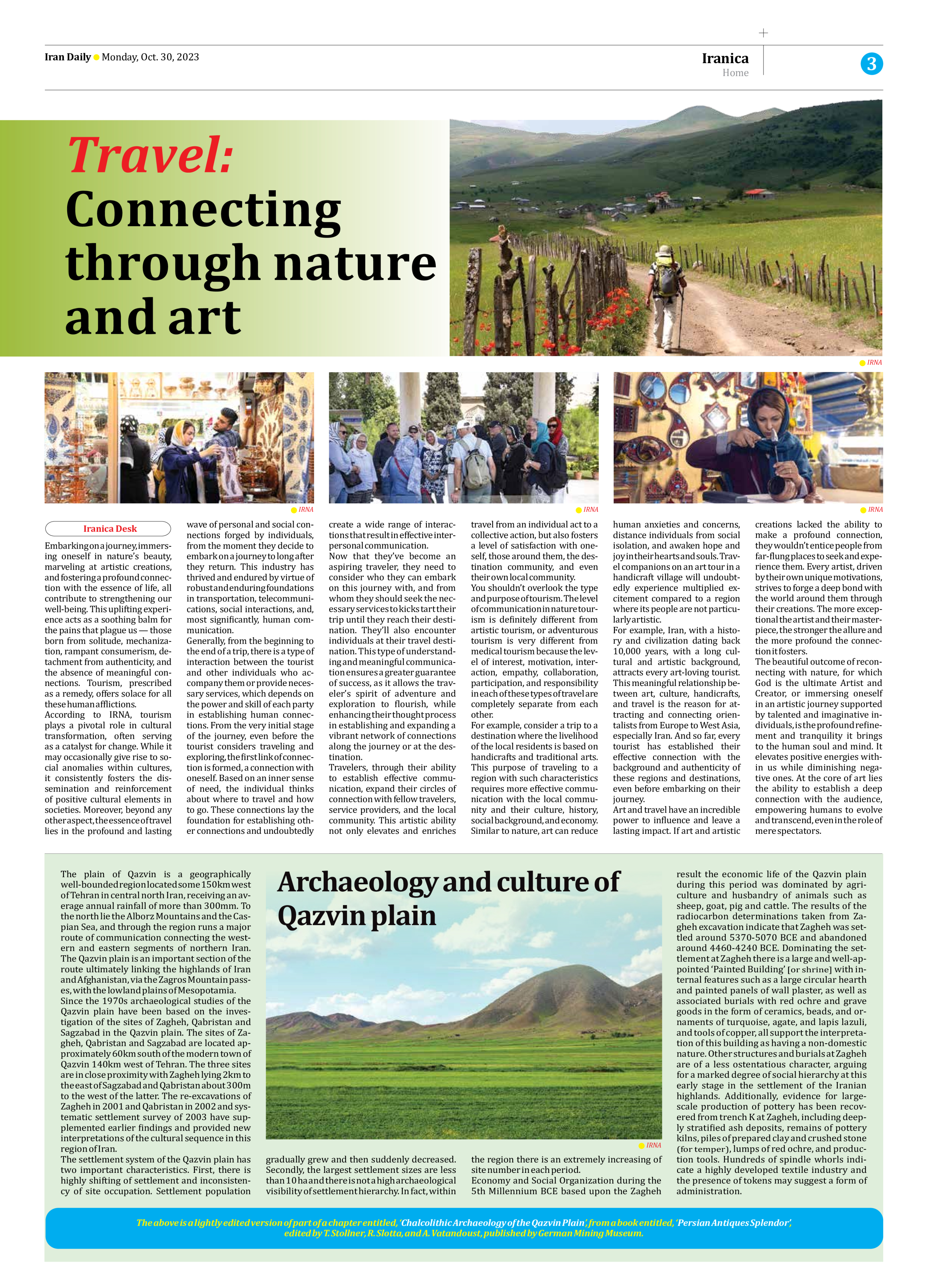
Travel: Connecting through nature and art
Embarking on a journey, immersing oneself in nature’s beauty, marveling at artistic creations, and fostering a profound connection with the essence of life, all contribute to strengthening our well-being. This uplifting experience acts as a soothing balm for the pains that plague us — those born from solitude, mechanization, rampant consumerism, detachment from authenticity, and the absence of meaningful connections. Tourism, prescribed as a remedy, offers solace for all these human afflictions.
According to IRNA, tourism plays a pivotal role in cultural transformation, often serving as a catalyst for change. While it may occasionally give rise to social anomalies within cultures, it consistently fosters the dissemination and reinforcement of positive cultural elements in societies. Moreover, beyond any other aspect, the essence of travel lies in the profound and lasting wave of personal and social connections forged by individuals, from the moment they decide to embark on a journey to long after they return. This industry has thrived and endured by virtue of robust and enduring foundations in transportation, telecommunications, social interactions, and, most significantly, human communication.
Generally, from the beginning to the end of a trip, there is a type of interaction between the tourist and other individuals who accompany them or provide necessary services, which depends on the power and skill of each party in establishing human connections. From the very initial stage of the journey, even before the tourist considers traveling and exploring, the first link of connection is formed, a connection with oneself. Based on an inner sense of need, the individual thinks about where to travel and how to go. These connections lay the foundation for establishing other connections and undoubtedly create a wide range of interactions that result in effective interpersonal communication.
Now that they’ve become an aspiring traveler, they need to consider who they can embark on this journey with, and from whom they should seek the necessary services to kicks tart their trip until they reach their destination. They’ll also encounter individuals at their travel destination. This type of understanding and meaningful communication ensures a greater guarantee of success, as it allows the traveler’s spirit of adventure and exploration to flourish, while enhancing their thought process in establishing and expanding a vibrant network of connections along the journey or at the destination.
Travelers, through their ability to establish effective communication, expand their circles of connection with fellow travelers, service providers, and the local community. This artistic ability not only elevates and enriches travel from an individual act to a collective action, but also fosters a level of satisfaction with oneself, those around them, the destination community, and even their own local community.
You shouldn’t overlook the type and purpose of tourism. The level of communication in nature tourism is definitely different from artistic tourism, or adventurous tourism is very different from medical tourism because the level of interest, motivation, interaction, empathy, collaboration, participation, and responsibility in each of these types of travel are completely separate from each other.
For example, consider a trip to a destination where the livelihood of the local residents is based on handicrafts and traditional arts. This purpose of traveling to a region with such characteristics requires more effective communication with the local community and their culture, history, social background, and economy. Similar to nature, art can reduce human anxieties and concerns, distance individuals from social isolation, and awaken hope and joy in their hearts and souls. Travel companions on an art tour in a handicraft village will undoubtedly experience multiplied excitement compared to a region where its people are not particularly artistic.
For example, Iran, with a history and civilization dating back 10,000 years, with a long cultural and artistic background, attracts every art-loving tourist. This meaningful relationship between art, culture, handicrafts, and travel is the reason for attracting and connecting orientalists from Europe to West Asia, especially Iran. And so far, every tourist has established their effective connection with the background and authenticity of these regions and destinations, even before embarking on their journey.
Art and travel have an incredible power to influence and leave a lasting impact. If art and artistic creations lacked the ability to make a profound connection, they wouldn’t entice people from far-flung places to seek and experience them. Every artist, driven by their own unique motivations, strives to forge a deep bond with the world around them through their creations. The more exceptional the artist and their masterpiece, the stronger the allure and the more profound the connection it fosters.
The beautiful outcome of reconnecting with nature, for which God is the ultimate Artist and Creator, or immersing oneself in an artistic journey supported by talented and imaginative individuals, is the profound refinement and tranquility it brings to the human soul and mind. It elevates positive energies within us while diminishing negative ones. At the core of art lies the ability to establish a deep connection with the audience, empowering humans to evolve and transcend, even in the role of mere spectators.







